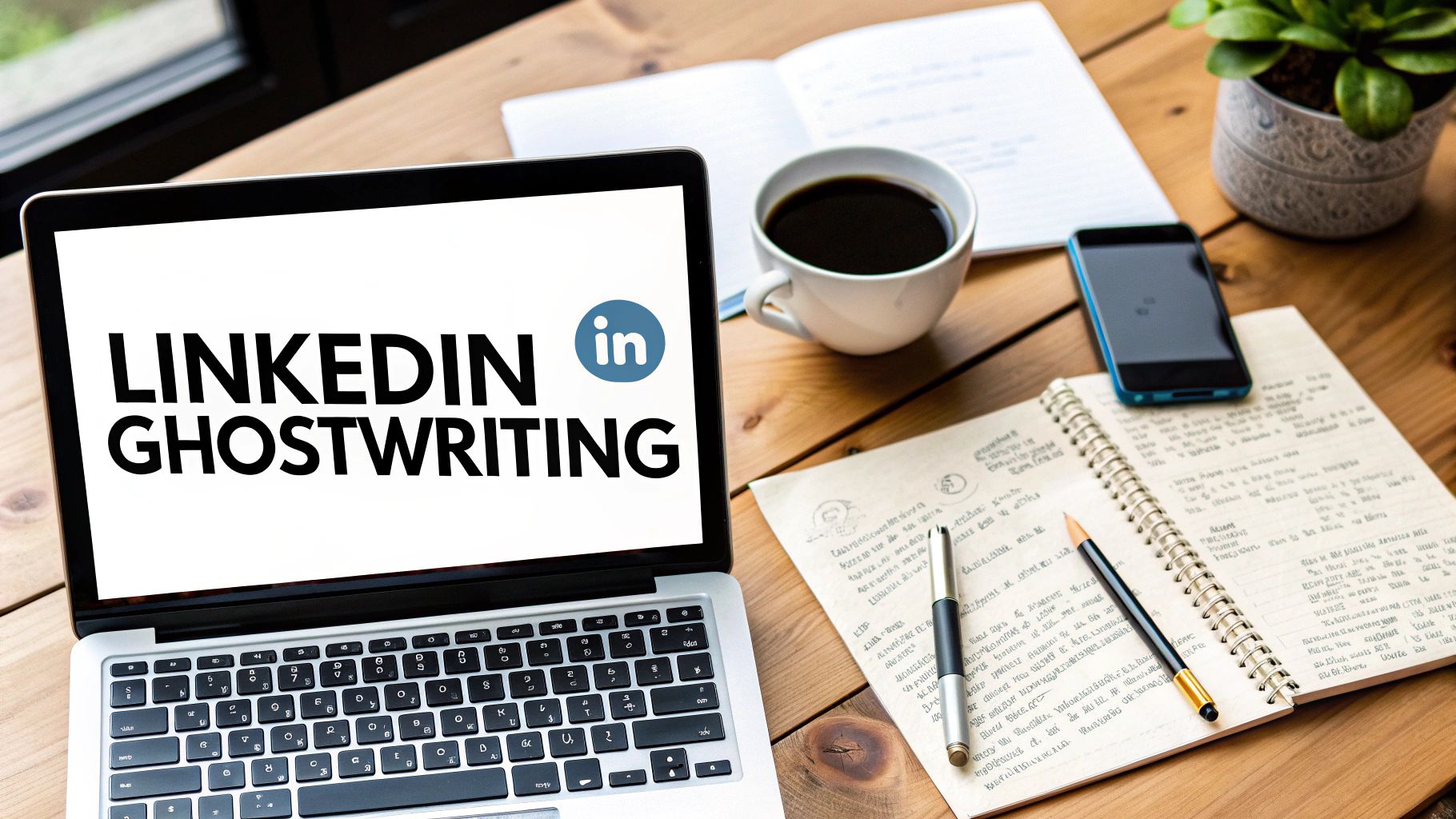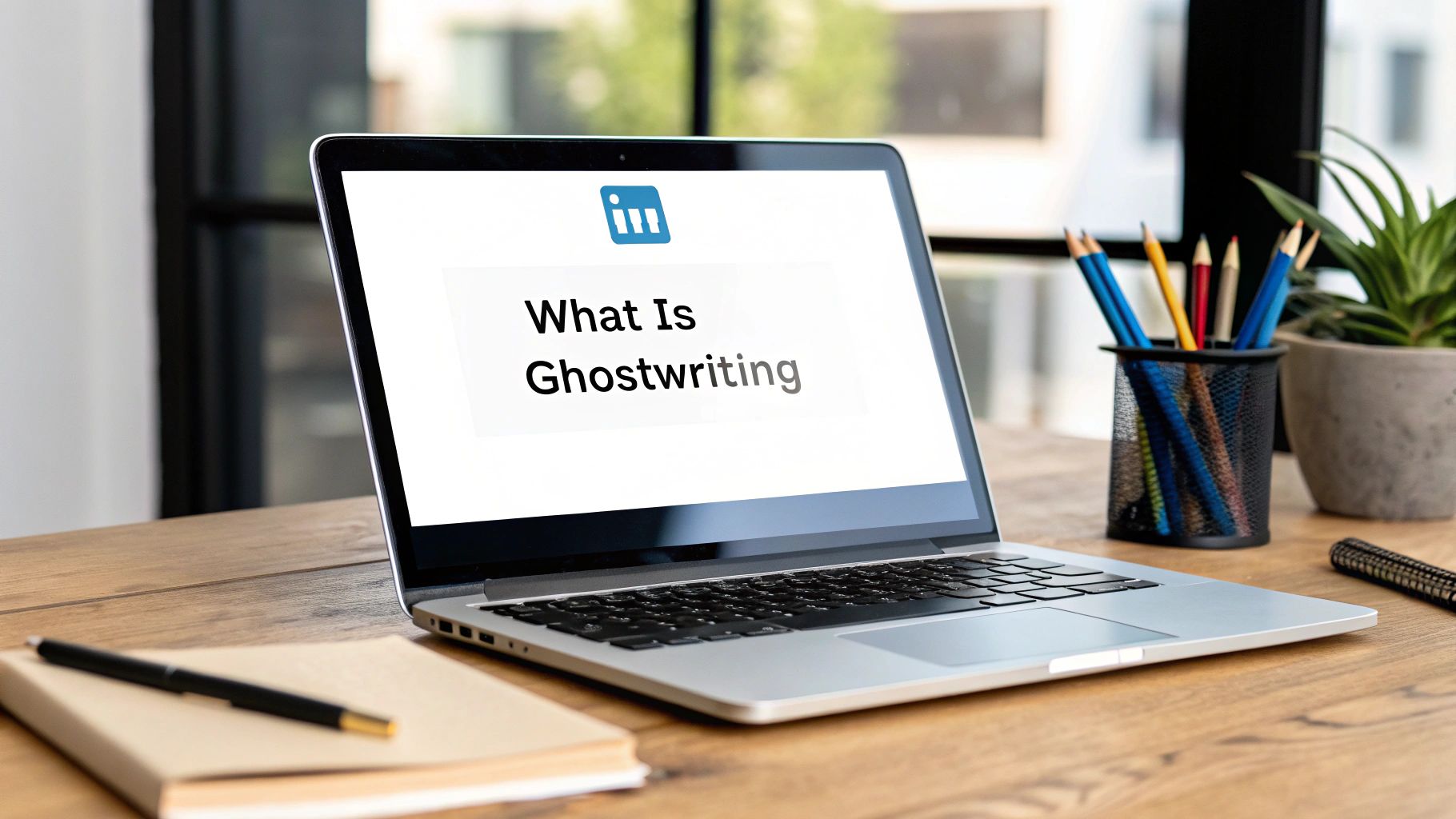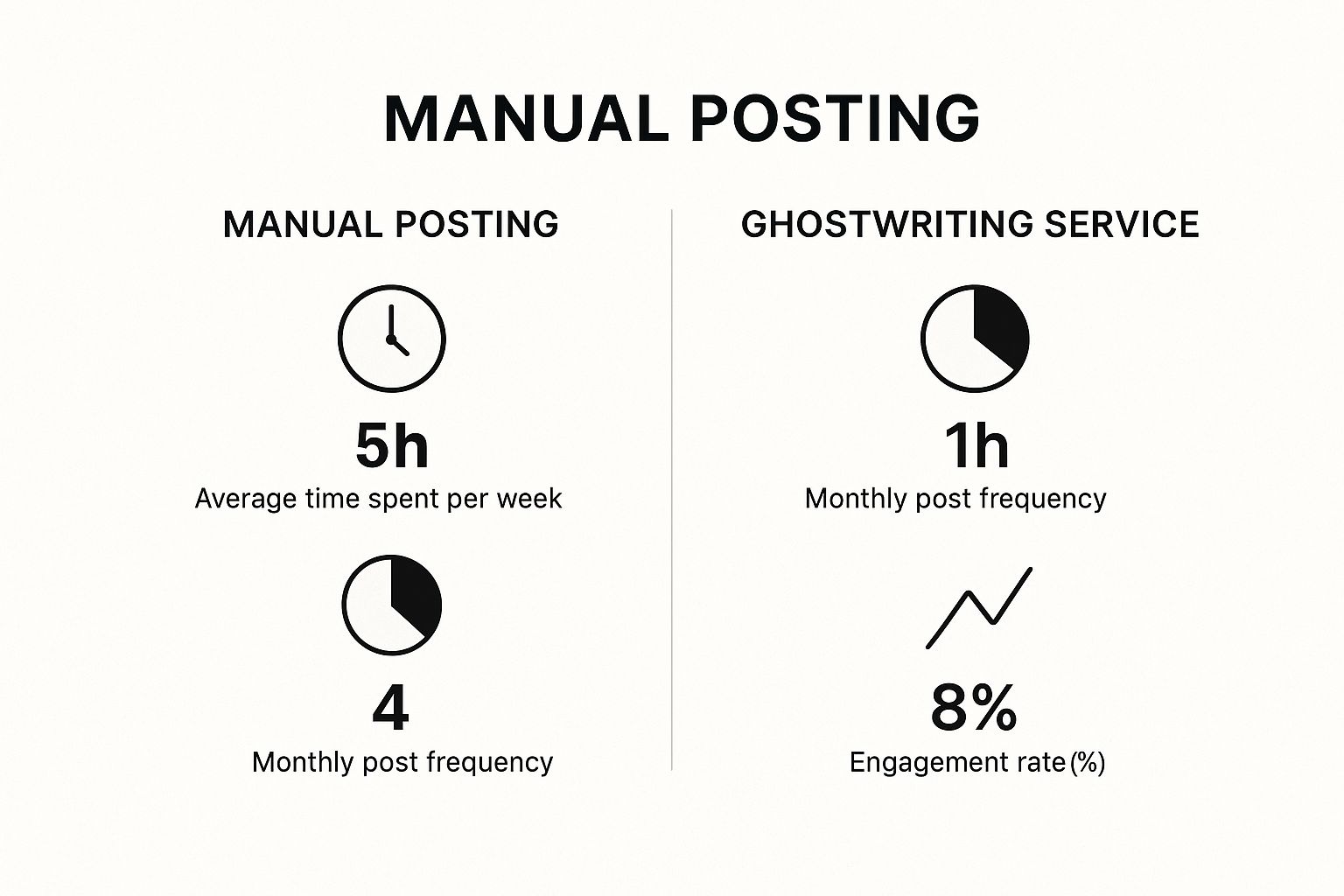
LinkedIn Ghostwriting: Boost Your Authority Today
Published on 2025-06-22
Why LinkedIn Ghostwriting Is Reshaping Professional Content
 The world of professional content has evolved, and LinkedIn ghostwriting is at the center of this change. Unlike other social platforms where quick updates and memes might work, LinkedIn plays by a different set of rules. Success on the platform requires a unique blend of authentic personality and deep industry expertise—a combination most busy executives and founders just don't have the time to master on their own. This is precisely where specialized ghostwriters step in.
The world of professional content has evolved, and LinkedIn ghostwriting is at the center of this change. Unlike other social platforms where quick updates and memes might work, LinkedIn plays by a different set of rules. Success on the platform requires a unique blend of authentic personality and deep industry expertise—a combination most busy executives and founders just don't have the time to master on their own. This is precisely where specialized ghostwriters step in.
This isn’t just about writing posts; it’s about strategic communication. A talented ghostwriter does more than just copy a client's writing style. They are more like translators, taking complex internal knowledge, raw opinions, and years of experience and shaping them into content that connects with a professional audience. They know what makes a peer stop scrolling—it's rarely a corporate announcement but almost always a relatable story or a bold, well-reasoned opinion.
The Strategic Value of Expert Storytelling
The growing popularity of ghostwritten content is a direct result of how business relationships are formed today. Authentic, insightful posts help an executive be seen not just as a leader in their company, but as an authority in their entire field. This difference is crucial for modern business development. Instead of pushing out generic company news, a ghostwriter helps an executive share real insights, mentor their audience, and join important industry discussions.
For example, a CEO might have a sharp take on a market trend but struggle to articulate it in a compelling way. A ghostwriter can pull out that core idea during a short chat and craft a post that sparks conversation and showcases the CEO's foresight. This strategic approach is why industry forecasts predict its growing importance. In fact, projections showed that by 2025, 80% of B2B sales interactions would take place in digital channels, making platforms like LinkedIn essential for building influence. You can explore more data on the strategic role of executive ghostwriters for modern business leaders to understand the full impact.
Uncovering Your Client's Authentic Professional Voice
The difference between a decent LinkedIn ghostwriter and a truly exceptional one boils down to a single, critical skill: capturing your client’s authentic professional voice. It's easy to think a quick questionnaire will do the trick, but top-tier writers know that voice discovery is an ongoing investigation. You’re not just mimicking your client; you're translating their unique stories, spoken rhythms, and core beliefs into powerful written content.
This infographic shows just how much of a difference a dedicated ghostwriting service can make compared to trying to manage it all yourself. The time saved directly translates into better, more consistent results.

As the data shows, handing off content creation can lead to posting 3x more frequently and driving 4x the engagement. All this, while cutting down your weekly time investment from five hours to just one.
From Conversation to Content
Your best source material won't come from a form; it will come from conversation. The richest insights are found by actively listening to how your clients discuss their work, their industry, and what keeps them up at night. Always get permission to record your discovery calls, then listen back. Pay attention not just to what they say, but how they say it.
- Listen for Analogies: Does your client use sports metaphors to explain business strategy? Or maybe cooking analogies to describe project management? These are little nuggets of gold for creating relatable content.
- Identify Pet Phrases: Do they have certain words or phrases they repeat often? Sprinkling these in (sparingly!) makes the writing feel instantly more genuine.
- Note Their Passion Points: Tune in to the topics that make them speak faster or with more energy. This is where their strongest opinions and most compelling stories are hiding.
To help you get started, here's a framework I use to guide the client discovery process. It ensures you cover all the essential bases right from the beginning.
Client Research Framework: Essential Discovery Areas A comprehensive breakdown of research categories and specific questions to ask during client onboarding.
| Research Category | Key Questions | Deliverable Output |
|---|---|---|
| Brand & Mission | What is the core mission of your personal brand? What problem do you solve for your audience? If your brand were a person, what three words would describe it? | A one-sentence brand mission statement. A list of 3-5 core brand attributes (e.g., "Innovative, empathetic, direct"). |
| Audience & Goals | Who is your ideal reader? What are their biggest challenges? What action do you want them to take after reading your posts? | Detailed audience personas. A list of primary and secondary content goals (e.g., "Generate 5 new leads per month"). |
| Voice & Tone | How do you want to sound (e.g., authoritative, humorous, inspirational)? Are there any words or phrases you love or hate? Can you give an example of a LinkedIn post you admire? | A "Voice & Tone" summary with specific dos and don'ts. Examples: "Avoid corporate jargon like 'synergy'," "Use contractions for a conversational feel." |
| Expertise & Stories | What are your key areas of expertise? What are some common misconceptions in your industry? Can you share a story about a major success or failure? | A running list of 10-15 core content pillars and potential story ideas to draw from for future posts. |
This framework isn't just a checklist; it's the foundation for a strong client relationship and content that truly represents them.
Building a Practical Voice Guide
With all this great raw material, it's time to organize it into a living document. A voice guide is more than a simple list of rules; it's a blueprint for your client's written persona. Move beyond abstract terms like "professional yet approachable" and use concrete examples. Instead of "be authoritative," your guide might say, "State opinions confidently without hedging words like 'maybe' or 'I think'."
This guide should grow and change with your client. After publishing a few posts, check in and ask, "Did this sentence feel like something you'd actually say?" or "Was this take a bit too aggressive for your style?" This collaborative feedback is the secret to long-term success. It ensures the content stays true to the person behind the profile, building a brand that feels both authentic and authoritative.
Writing Opening Lines That Command Professional Attention
 On LinkedIn, your first sentence is a make-or-break moment. A busy executive scrolling through their feed makes a split-second decision to either stop or keep moving, and that choice rests entirely on your opening line. The core challenge for any LinkedIn ghostwriting professional is to grab attention without sacrificing credibility. If you lean too far into clickbait, you risk damaging your client's reputation; stay too formal, and you simply become invisible. The sweet spot is all about creating genuine curiosity.
On LinkedIn, your first sentence is a make-or-break moment. A busy executive scrolling through their feed makes a split-second decision to either stop or keep moving, and that choice rests entirely on your opening line. The core challenge for any LinkedIn ghostwriting professional is to grab attention without sacrificing credibility. If you lean too far into clickbait, you risk damaging your client's reputation; stay too formal, and you simply become invisible. The sweet spot is all about creating genuine curiosity.
A powerful opening line sets the stage for the entire post. One of the most effective ways to do this is by leading with a story. Research from Stanford University revealed that stories are up to 22 times more memorable than just facts. This insight is gold for ghostwriters trying to captivate decision-makers from the very first word. When you wrap a key takeaway in a short narrative, the message sticks. You can see how successful ghostwriters apply these techniques to learn how storytelling captivates busy CEOs.
Crafting Hooks That Connect
Beyond storytelling, there are several other reliable ways to write a compelling hook. The goal isn't just to be seen but to spark a real reaction that gets people talking and thinking.
Here are a few proven types of opening lines that work well:
- The Controversial (But Defensible) Take: Start with a bold opinion that goes against a common industry belief. For example, instead of saying, "Networking is important," you could open with, "Your professional network is useless... unless you do this one thing." This creates immediate intrigue.
- The Relatable Confession: Open with a vulnerable admission or a lesson learned from a past mistake. An opener like, "I blew my first six-figure deal because I didn't understand this simple negotiation tactic," is incredibly human and draws people in.
- The Surprising Statistic: Use a startling number or fact to frame a problem. For instance, "Only 8% of people achieve their New Year's resolutions. Here's the psychological reason why, and how it applies to business goals."
The key is to match the hook to your client’s personality and industry. A conservative finance executive might prefer a data-driven opener, while a tech founder could lean into a more provocative statement. No matter which approach you choose, a strong opening acts as a promise to the reader: "This post is worth your time." Mastering these opening lines is a fundamental part of learning how to write engaging LinkedIn posts that deliver results.
Structuring Posts That Keep Busy Professionals Reading
Once you’ve grabbed a reader with a killer opening line, the post's structure is what keeps them from scrolling away. On LinkedIn, people don't just read; they scan. Professionals checking their phones between meetings simply don’t have the time for massive walls of text. This is why getting the structure right is a fundamental skill in **LinkedIn ghostwriting**—the real goal is making complex ideas feel simple to absorb.Think of it as creating a clear visual path for the reader's eyes. Your hook makes them stop, but it's the post's flow and design that guide them all the way to your call-to-action. The most effective posts use strategic white space, with plenty of line breaks between short paragraphs, to build a sense of forward motion. A post that looks easy to read is far more likely to get read, especially on mobile, where most LinkedIn users are.
The Anatomy of a High-Performing Post
There’s no magic number for post length, but the sweet spot for most thought leadership pieces is between 150 and 250 words. This gives you enough room to explore an idea properly without overwhelming the reader. While shorter posts have their place for quick updates, you need more substance to really build authority. The most common structure is a simple one: a strong hook, a few body paragraphs that develop your point, and a clear closing.
Let's look at the key elements that make a post readable and compelling:
- The Single-Sentence Paragraph: Want to make a point stick? Put it on its own line. A one-line paragraph forces the reader to pause and consider its weight. It's a visual signal that says, "Hey, this part is important."
- Bulleted or Numbered Lists: When you're sharing several tips, steps, or examples, lists are your best friend. They break up the text and make information much easier to scan and digest. For instance, outlining three common industry mistakes is far more impactful in a bulleted list than buried inside a paragraph.
- The Concluding Question or CTA: Every post should lead somewhere. You can wrap up by asking a question to spark conversation ("What's the biggest challenge you see?") or by including a direct call-to-action ("Follow for more insights on team leadership."). This gives your audience a next step, turning them from passive readers into active followers.
By focusing on a clean, scannable format, a ghostwriter ensures that a client's expertise isn't just shared, but actually understood. It shows respect for the reader's time, which makes them more likely to engage with future content. This careful approach to formatting is what separates amateur posts from professional, results-driven LinkedIn ghostwriting.
Creating Content Strategies That Generate Business Results

While likes and comments feel good, serious clients hire a ghostwriter for one reason: to achieve real business outcomes. A strong LinkedIn ghostwriting partnership is built on a strategy that ties every single post back to a specific business goal. Whether your client wants to generate qualified leads, become the go-to expert in their field, or attract top talent, your content needs to be engineered to make that happen.
This means getting away from random, disconnected posts and building a true content plan. A solid strategy begins by identifying content pillars that not only highlight your client's expertise but also speak directly to the frustrations and challenges their ideal customers face every day. You're creating a content ecosystem where each piece builds on the last, making your client the obvious choice for their services. For a deeper look at this process, check out this guide on building a content strategy for LinkedIn.
From Engagement to Business Impact
This is where good writers become great partners—by connecting content directly to business goals. A well-executed strategy can genuinely shift a client's professional standing and fill their business development pipeline.
Consider the 2023 case study of a client named David, who was stuck just promoting his products. He hired a LinkedIn ghostwriter to pivot his strategy toward sharing genuinely helpful insights with small business owners. The results were telling: in just one year, his engagement rate shot up by 68%. More importantly, demo requests from LinkedIn jumped by 45%, proving a direct connection between his new content and new business. You can explore the full story about the power of strategic LinkedIn content to see the impact for yourself.
Defining What Success Looks Like
To prove your efforts are working, you need to define and track the right metrics from day one. Instead of just looking at vanity metrics, focus on the numbers that show real progress toward your client's main objectives.
Here are a few ways to measure success based on common business goals:
- For Lead Generation: Keep an eye on inbound messages that mention a specific post, track demo requests that come directly from LinkedIn, or monitor clicks on links to lead magnets.
- For Authority Building: You'll want to watch for a rise in profile views, an increase in connection requests from high-value contacts, and new invitations to speak at events or appear on podcasts.
- For Brand Awareness: Look at follower growth over time, track post reach and impressions, and take note of mentions by other industry leaders.
To help you and your client stay aligned, it’s helpful to map out these KPIs clearly. The table below outlines how different business goals connect to specific primary and secondary metrics, along with realistic benchmarks for success.
| Business Goal | Primary Metrics | Secondary Metrics | Success Benchmark |
|---|---|---|---|
| Lead Generation | Demo requests from LinkedIn | Clicks on lead magnets | 15-25% increase in qualified leads QoQ |
| Authority Building | Speaking/podcast invites | Profile views from target audience | 3-5 high-value opportunities per quarter |
| Brand Awareness | Follower growth rate | Post impressions and reach | 5-10% monthly follower growth |
| Talent Attraction | Inbound messages from candidates | Clicks on "Careers" page link | 10+ qualified applicants from LinkedIn per month |
By tracking these outcome-focused metrics, you can clearly demonstrate the value of your LinkedIn ghostwriting services. You’re no longer just a writer; you're a strategic partner contributing directly to your client’s success.
Building Your LinkedIn Ghostwriting Practice That Pays
If you want to turn your writing talent into a successful LinkedIn ghostwriting business, you need to think beyond just creating good content. The real money is in how you position yourself. Not all ghostwriting gigs are the same, and knowing which niches pay top dollar is your first move toward a profitable career. While generalist writers often find themselves in a race to the bottom on price, specialists who understand complex industries always earn more.
It makes sense when you think about it—specialized knowledge is something you can't just pick up overnight. For example, a ghostwriter who truly gets the compliance and regulatory side of the healthcare industry offers much more value than someone writing generic leadership posts. The same goes for technical fields like FinTech or SaaS, where your credibility hinges on getting the details and industry-specific language just right. Clients in these areas aren't just paying for words; they're hiring a partner who can speak their language and represent their expertise with precision.
Finding Lucrative Ghostwriting Niches
The need for expert LinkedIn ghostwriting is on the rise, especially in high-stakes industries where clear and authoritative communication is non-negotiable. The highest-paying niches right now include healthcare, technical writing for AI and SaaS companies, and executive personal branding. A talented healthcare ghostwriter, for instance, can charge anywhere from $30 to $180 an hour because they can write content that builds trust while navigating strict compliance rules. You can discover more about the most profitable ghostwriting niches to explore where your own skills might be the best fit.
Structuring Your Services for Growth
Once you've zeroed in on a niche, the next step is to structure your services in a way that allows you to grow. Simply trading your time for money is a quick path to burnout. The most successful ghostwriters package their work into monthly retainers, which creates a steady, predictable income and helps build stronger, long-term relationships with clients.
Think about offering tiered packages to meet different client needs:
- Content Creation: This could include a specific number of posts per month, covering research, writing, and editing.
- Strategy & Management: On top of content, this tier might involve monthly strategy calls, performance reports, and some light comment engagement to keep the conversation going.
- Full-Service Authority Building: Your top-tier package could add valuable extras like profile optimization, a network growth strategy, or even help in finding speaking gigs for your client.
This approach shifts you from being just a writer to becoming a strategic partner. As you start managing several accounts, using smart tools can help you keep up with the workload without sacrificing quality. For example, you could read up on using a ghostwriter AI to draft initial post ideas or handle scheduling. This frees you up to focus on what really matters: high-level strategy and client relationships. This is how you build a ghostwriting practice that not only pays well but is also built to last.
Your LinkedIn Ghostwriting Success Blueprint
Succeeding as a LinkedIn ghostwriter goes beyond just writing well. It's about building a solid plan that gets you ready for the real world of client work. This blueprint is designed to help you handle common issues, from tricky client demands to keeping your quality high as you grow.
From Onboarding to Offboarding
A smooth operation always begins with a great client onboarding process. Before you even think about writing, create a standard checklist to make sure you have everything you need. This should include signed contracts, access to brand assets like logos and color palettes, and a completed voice discovery questionnaire. Getting this sorted out upfront prevents a lot of headaches later and shows you're a pro from day one.
It's just as important to recognize when a client relationship isn't the right fit. Look out for red flags like constant scope creep (where they keep adding more work), late payments, or a core difference in vision that revisions can't fix. If these problems pop up, you need a professional offboarding process. State your decision clearly in writing, hand over all the finished work, and give them a fair amount of time to find a new writer. A graceful exit protects your reputation.
Scaling Your Practice Intelligently
As you get more clients, your biggest test will be maintaining the quality of your work. The secret isn't to work more hours, but to build smart systems.
- Standardize Your Workflow: Create templates for things you do often, like content calendars, client progress reports, and feedback forms. This consistency saves mental energy and makes sure every client receives the same great service.
- Time-Block Your Activities: Set aside specific chunks of your day for different tasks—writing, talking to clients, and finding new business. This keeps you from feeling pulled in a million directions and helps you focus.
- Track Performance That Matters: Pay attention to the metrics that actually help your client's business. This could be an increase in lead inquiries or more profile views from their target companies, not just vanity metrics like likes and comments.
Building a successful LinkedIn ghostwriting business takes time and effort. By putting these structured methods in place, you can grow your business in a sustainable way while delivering fantastic results for your clients.
Ready to put these strategies into action with powerful tools? autoghostwriter helps you create high-quality, authentic LinkedIn posts with advanced AI, freeing you to focus on strategy and client relationships.